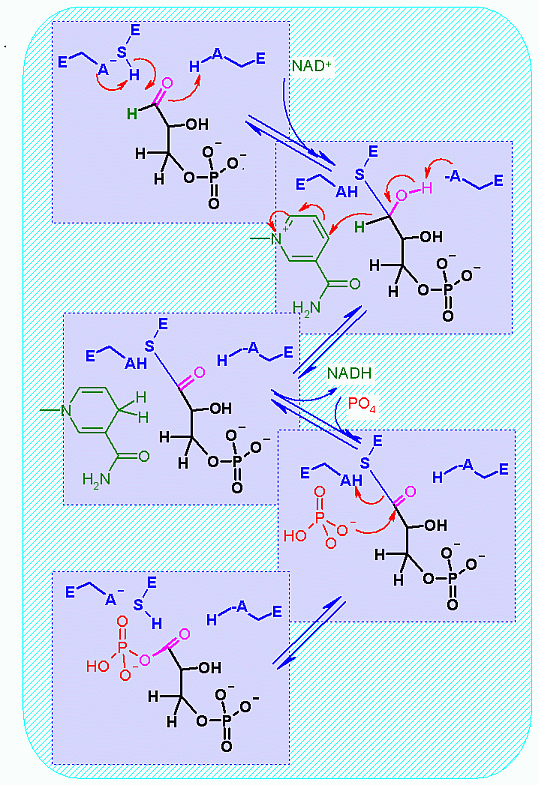 Glyceraldehyde-3-Phosphate Dehydrogenase
Information
Glyceraldehyde-3-Phosphate Dehydrogenase
Information Glyceraldehyde-3-Phosphate Dehydrogenase
Information
Glyceraldehyde-3-Phosphate Dehydrogenase
Information
|
Enzyme Name |
Glyceraldehyde-3-Phosphate Dehydrogenase |
|
|
|
||
|
Reaction Catalyzed |
two step reaction:
This order reverses for
gluconeogenesis
|
|
|
Reaction Type |
Two Step Reaction
|
|
|
Rationale |
Oxidation of an aldehyde to an acid (combined with a one slight trick). The core of this reaction is the NAD+ dependent oxidation of the aldehyde in glyceraldehyde to an organic acid (glycerate). The slight trick here is that it is actually converted to the
phosphoanhydride rather than a free organic acid. This can be
accomplished becuase of a covalently bound intermedicate in the enzyme.
This is described in much more detail in the mechanism section below. The justification for the twist lies in thermodynamics of the next step. Remember, in one of the quiz questions, two modules ago, I indicaited that the amount of energy released from phosphoanhydride hydrolysis is MUCH higher than that for hydrolysis of a phosphate from an hydroxyl group. This extra energy is used in the next step to MAKE an ATP! (more on energy coupling later in this module). Summing up - TWO ATP were needed to start the glycolysis pathway (hexokinase and phosphofructokinase-1) . NOW two ATP (remember there are two 3-phosphoglycerate for every glucose) are made in the following reaction... we will be back where we started in number of ATP |
|
|
Pathway Involvement |
Glycolysis AND gluconeogenesis |
|
|
Cofactors/Cosubstrates |
cosubstrates NAD+ and PO4=
are both required in the glycolsys direction. NADH is a coproduct |
|
|
|
||
|
DGo' |
+6.3 kJ/M |
Starting from standard state and allowing the reaction to come to equilibrium the substrates of glycolysis (G-3-P, PO4 and NAD+) concentration would end up ~12 times higher than the product of the concetrations of 1,3 bisphosphoglycerate NADH. The Standard Free Energy favors Fructose-1,6-bisphosphate production. |
|
Keq |
 |
|
|
Comments |
This reaction is made possible because of two factors:
|
|
|
"In cell" Substrate Concentrations* |
||
|
S1 = |
Glyceraldehyde-3-Phosphate | 0.019 mM |
|
S2 = |
NAD+ |
0.0003 mM
|
| S3= |
PO4= |
1.0 mM |
|
P1 = |
1,3 bisphosphoglycerate |
0.001 mM |
|
P2 = |
NADH |
0.000003 mM |
|
DG for these conditions |
 |
|
|
-1.3 kJ/M |
||
|
|
||
|
Mechanism for Chemistry step one |
 |
|
|
Mechanism for Enzyme |

|
|
|
Picture of Enzyme with substrate |
|
|
|
|
|
|
|
Glyceraldehyde-3-Phosphate Dehydrogenase CHIME representation |
|
*= These are concentrations obtained for one set of conditions. These will change as physiology and activity change.